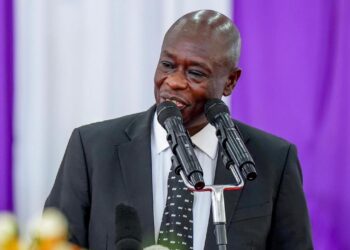The Kenya Human Rights Commission (KHRC) released a scathing report on August 4, 2025, titled Failing the Hustlers, demanding the immediate shutdown of the Hustler Fund due to a 68% default rate and significant financial losses, arguing it fails to empower low-income Kenyans as promised under the Kenya Kwanza administration’s Bottom-Up Economic Transformation Agenda (BETA).
Launched in November 2022 with a Ksh50 billion startup capital, the fund’s 14-day repayment window for loans averaging Ksh925 has led to unsustainable debt cycles, with taxpayers bearing a 71.5% net loss.
Government officials, including Cooperatives Cabinet Secretary Wycliffe Oparanya, defended the program, highlighting its role in providing affordable credit to over 26 million Kenyans and mobilizing Ksh5 billion in savings.
Hustler Fund Shutdown Demand
The KHRC’s Failing the Hustlers report calls for the Hustler Fund’s termination, citing its 68.3% default rate by December 2024, with Ksh340 lost for every Ksh500 disbursed.
The commission estimates taxpayers absorb losses exceeding Ksh50 million daily, with Ksh53 billion disbursed by September 2024 showing no measurable impact on job creation or enterprise development.
The fund’s budget has been slashed from Ksh10 billion in 2023/24 to Ksh300 million in 2025/26, reflecting declining confidence. KHRC argues that the program, designed to provide microloans to informal workers like boda boda riders and small traders, is structurally flawed, economically unsustainable, and politically manipulated as a tool for post-election patronage rather than genuine empowerment.
Hustler fund 68% Default Rate Crisis
The 68% default rate, up from 32% in 2023 as per the Auditor General’s report, underscores the Hustler Fund’s repayment crisis. By June 2024, Ksh8.74 billion of the Ksh13.57 billion loan portfolio remained unpaid, with elderly borrowers (over 90) defaulting at 78%, followed by those under 30 at 12%.
The 14-day repayment period for loans as low as Ksh500 is deemed unrealistic, pushing borrowers into repeat borrowing cycles. The lack of a dedicated loan management system and reliance on private providers like Safaricom and Kenya Commercial Bank for disbursement exacerbate recovery issues, with unsupported transactions and missing documentation flagged by the Auditor General, undermining transparency.
Hustler fund Financial Losses to Taxpayers
The financial losses to taxpayers are stark, with KHRC estimating a 71.5% net loss when factoring in an 8.2% Treasury bill rate and 3% operational costs.
For every Ksh500 loan, Ksh358 is effectively unrecoverable, costing taxpayers heavily. The fund’s opaque governance, lacking an oversight board and proper audit trails, violates public finance laws, as noted by the Auditor General’s inability to verify Ksh3.35 billion in cash balances.
KHRC criticizes the fund’s reliance on National Treasury borrowing, arguing it diverts resources from critical sectors like healthcare and education, especially amid Kenya’s economic challenges, including a 6.7% inflation rate in 2024.
Hustler Fund Political Patronage
KHRC’s report accuses the Hustler Fund of serving as a political tool rather than a financial empowerment mechanism. Launched as a flagship of President William Ruto’s 2022 campaign, the fund’s design prioritizes political messaging over sustainability, fostering a perception of loans as handouts, which erodes credit discipline.
Nairobi, Kiambu, and Nakuru counties lead in loan uptake, but the lack of financial literacy programs and business support services limits entrepreneurial success.
Critics, including Busia Senator Okiya Omtatah, argue the fund’s centralized structure in Nairobi detaches it from grassroots needs, violating constitutional public finance principles.
Government Defense of Hustler Fund
Government officials, led by Wycliffe Oparanya, have dismissed the KHRC report as “skewed, elitist, and politically motivated,” arguing it relies on outdated 2022 data.
Oparanya claims over 26 million Kenyans have accessed Ksh72 billion, with Ksh60 billion repaid, and 9 million active borrowers benefiting daily.
The fund’s digital platform, accessible via USSD, has extended credit limits to Ksh150,000 and repayment periods to 30 days, supporting small-scale farmers and informal workers.
Principal Secretary Susan Mang’eni emphasized its role in transitioning 1 million borrowers to formal banking, countering claims of failure with evidence of improved credit ratings.
However, some defend its accessibility, noting its role in financing small needs like motorbike repairs.















